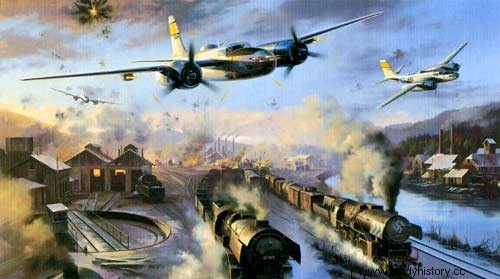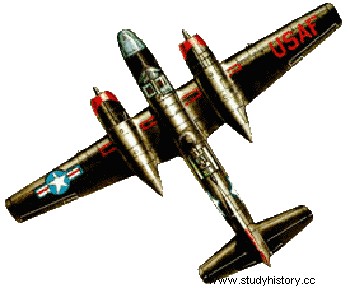
dates
 commissioning date:1943
commissioning date:1943
 end of use date:70s
end of use date:70s
Nationalities
 Constructor:
Constructor:
- USA
 Users :
Users :
- USA
- France
- South Vietnam

Categories
 Assault aircraft
Assault aircraft

Technical Data and Performance
 Width :21.35 m
Width :21.35 m
 Length:15.47 m
Length:15.47 m
 Height :
Height :
 Weight :
Weight :
 Maximum Weight :15,880 kg
Maximum Weight :15,880 kg
 Maximum Charge :
Maximum Charge :
 Surface :
Surface :
 Maximum Altitude :
Maximum Altitude :
 Autonomy :2,900 km
Autonomy :2,900 km
 Maximum Speed :570 mph
Maximum Speed :570 mph
 Ascensional Velocities :
Ascensional Velocities :
 Practical Ceiling :
Practical Ceiling :
 Cruise Speed :
Cruise Speed :

Motorization (engines or reactors)
 2 Pratt &Whitney R-2800-27/79 of 2,000 ch
2 Pratt &Whitney R-2800-27/79 of 2,000 ch
Armaments
 up to 20 12.7 mm machine guns,
up to 20 12.7 mm machine guns,
 offensive charge, 1,810 kg of `bombs in soute and 910 kg under veil, or 8 rockets of 127 mm , or 16 rockets of 76 mm
offensive charge, 1,810 kg of `bombs in soute and 910 kg under veil, or 8 rockets of 127 mm , or 16 rockets of 76 mm
The almost incredible operational career of the Douglas A-26 Invader began in 1944 in Europe and continued through the Vietnam conflict. This device traversed three wars and turned out to be the best — and also the last — ground attack and tactical bombing aircraft used in combat by US aviation. The Invader also represented the highlight of the evolution of the long series of lightweight high-performance twin engines produced by the Douglas from 1936 onwards, a series that included the DB-7 and subsequent Boston Havocs. The number of Invaders built rose to 2,446 copies in all and the end of the conflict entailed the cancellation of 5,254 more machines of more powerful and improved versions.
In 1940, the USAAF requested the development of a new twin-engined light bomber capable of high performance and powerfully armed. The development and launch of the Douglas project progressed very rapidly. After the order for three prototypes, placed in June 1941, the first of these devices flew thirteen months later, on 10 July 1942. Called the XA-26, it presented itself as a traditional bomber, muni of machine guns mounted in the windshield . . . . The second prototype, the XA-26A, had the look of a night fighter, provided with an armament type very similar to that of the Northrop P-61 Black Widow, its contemporary:four heavy machine guns housed in a remotely controlled turret on the back and four 20-millimeter guns lodged in the belly.
Finally, the third prototype, the XA-26B, had been armed, as the "gunned" version of the North American 8-25 Mitchell, of a forward-mounted 75-millimeter cannon. After performing a series of comparative ground and flight tests, the Americans chose the latter prototype as the basis for production. They eliminated the cannon and, in its place, mired six heavy machine guns in the nose of the device, to which they added four other guns mounted in two remote-controlled turrets, one dorsal and one ventral. On special mission, this powerful shipboard armament could be supplemented by ten other machine guns:eight in the wings, placed two by two in four housings, two more on each side of the fuselage, located in two exterior slots.
Furthermore, for ground attack, the two machine guns lodged in the upper turret could be locked forward and controlled by the pilot himself.
Finally, the soute was capable of holding up to 1,815 kilograms of bombs and, if necessary, the wing supports could carry additional tank loads, another 907 kilograms of bombs or sixteen rockets.
The Douglas commissioned production of the initial A-26B version, built to 1,355 copies, using two mounting chains. The first devices appeared in mid-1944, underwent the baptism of fire on 19 November and proved, within the 9th Air Force in Europe, the fastest bombers ever used by the USAAF during the conflict. A few months later, they would become operational in the Pacific.
The year 1945 saw the appearance of the second version, the A-26C, which shouldered the former in operations against Japan. The Americans built these Invaders as regular bombers provided with a glass nose and reduced armament. The number of A-26Cs manufactured rose to 1,091.
In the immediate postwar period, several hundred A-26s remained in service and, in June 1948, they received the designation B-26, after the abolition of the A-category (light bomber)and the radiation of all Martins B-26 Marauder. During the course of the Korean War, the Invader connured intense operational employment. One of these machines took part in the last bombing operation of this conflict.
